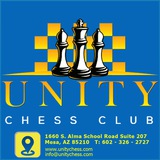It was essential to test the opponent in the variation 22.Bxc6 Nxf1 23.Bg2 Rg6 24.f4, although here too, Black wins:
24...Nxe3! (24...Nxh2? 25.Kh1! is already good for White) 25.Rxe3 Qxe3+ 26.Kh1 e4 27.Bc1 Rxg2 28.Qxg2 Qb3 29.Rxd6 Nf8 30.Bb2 g6 31.h4 Qxc4 32.h5 Rc8 33.hxg6 hxg6 34.Rxg6+ Nxg6 35.Qxg6+ Kf8 36.Qxf5+ Ke8–+.
24...Nxe3! (24...Nxh2? 25.Kh1! is already good for White) 25.Rxe3 Qxe3+ 26.Kh1 e4 27.Bc1 Rxg2 28.Qxg2 Qb3 29.Rxd6 Nf8 30.Bb2 g6 31.h4 Qxc4 32.h5 Rc8 33.hxg6 hxg6 34.Rxg6+ Nxg6 35.Qxg6+ Kf8 36.Qxf5+ Ke8–+.
22...Bxf3 23.Rd2 Qg4 24.Qb3 Kh8 25.Rf2 Rc8 26.c5 bxc5 27.Qf7 Nf6 28.Qe6 Rg8 29.Qxd6 Ne4 30.Qxe5 Ng5
Unity Chess Club
Anatoly Karpov 2740 Veselin Topalov 2640 Dos Hermanas 1994 White to move
When the queen is on e4 and the rook on e8, one naturally wants to be able to fork them. The f6-square is guarded only by the king, and is under an x-ray from the white queen. Thus, we get the following tactical motif:
As a result of a forcing combination, two black bishops are under attack.
Unity Chess Club
Sopio Gvetadze 2377 Salome Melia 2422 Tbilisi ch-GEO W 2009 Black to move
The correct decision is not to drive the white king further towards the corner, but to draw him out into the centre:
In the game, Black missed the win and chose the quiet developing move 16...Rad8?. White was not up to the task, and after 17.Re5? (she could have avoided loss of a piece with the only move 17.Kg1! Qg5 18.c4 Bxd5 19.cxd5 Rxd5 20.Qxa7 Rd2 21.Qe3 Qd5 22.Qe4=) 17...Rxd5 18.Qxd5 Bxd5 19.Rxe7 Bxh1 20.c4 Bc6, lost anyway.
Unity Chess Club
Training position Konstantin Landa White to move
White can mate with a series of fireworks:
